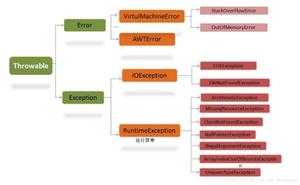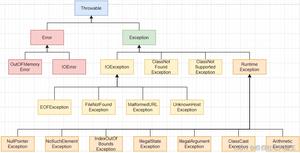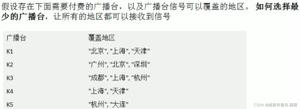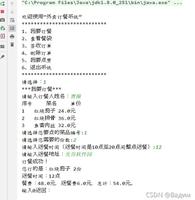java 竞赛常用方法

一,基本数据类型
1.int,float.double等转换为字符串用 String.valueOf方法
eg:double转换为String
Double dtDouble=12.31354;String string=String.valueOf(dtDouble);
System.out.println(string);
2.字符串转换为int,float,double等用其引用类型的parse对应的方法
eg:string 转换为double
String string="1.254849";Double dt1=Double.parseDouble(string);
System.out.println(dt1);
3.double保留两位小数
DecimalFormat为java.text.DecimalFormat
double d = 32.1415926;//0.00就是两位,0.000就是三位,依此类推
DecimalFormat decimalFormat=new DecimalFormat("0.00");
String d1=decimalFormat.format(d);
System.out.println(d1);//32.14
二,大数运算
1.BigDecimal
如果直接使用double计算,可能会出现以下情况
double t=1.0-2.2*1.0;System.out.println(t);//-1.2000000000000002
所以double做精确计算时推荐使用BigDecimal
BigDecimal使用教程
import java.math.BigDecimal;public class testDecimal {
public static void main(String[] args) {
double d1=0.01;
double d2=0.02;
BigDecimal d1BigDec=new BigDecimal(Double.toString(d1));
BigDecimal d2BigDec=new BigDecimal(Double.toString(d2));
//加法
BigDecimal addB=d1BigDec.add(d2BigDec);
Double add=addB.doubleValue();
System.out.println(add);//0.03
//减法
BigDecimal subB=d1BigDec.subtract(d2BigDec);
Double sub=subB.doubleValue();
System.out.println(sub);//-0.01
//乘法
BigDecimal mulB=d1BigDec.multiply(d2BigDec);
Double mul=mulB.doubleValue();
System.out.println(mul);//2.0E-4
//除法一
BigDecimal divB=d1BigDec.divide(d2BigDec);
Double div=divB.doubleValue();
System.out.println(div);//0.5
//除法二(如果有除不尽的,会报异常,需要自己指定保留几位小数)
//注意这个divide方法有两个重载的方法,一个是传两个参数的,一个是传三个参数的:
//两个参数的方法:
//@param divisor value by which this {@code BigDecimal} is to be divided. 传入除数
//@param roundingMode rounding mode to apply. 传入round的模式
//三个参数的方法:
//@param divisor value by which this {@code BigDecimal} is to be divided. 传入除数
//@param scale scale of the {@code BigDecimal} quotient to be returned. 传入精度
//@param roundingMode rounding mode to apply. 传入round的模式
double dt1=2.0;
double dt2=3.0;
BigDecimal dt1BigDec=new BigDecimal(Double.toString(dt1));
BigDecimal dt2BigDec=new BigDecimal(Double.toString(dt2));
//保留六位小数
BigDecimal divideB = dt1BigDec.divide(dt2BigDec, 6, BigDecimal.ROUND_HALF_UP);
double divide = divideB.doubleValue();
System.out.println(divide);//0.666667
}
}
除并求余运算
import java.math.BigDecimal;public class Main {
public static void main(String[] args) {
BigDecimal amt = new BigDecimal(1001);
BigDecimal[] results = amt.divideAndRemainder(new BigDecimal(50));
//商 20
System.out.println(results[0]);
//余数1
System.out.println(results[1]);
}
}
三,数组
1.数组自带的方法
2.操纵数组类Arrays(java.util.Arrays)
sort
升序
int scores[] = new int[]{1,2,3,89,4};Arrays.sort(scores);
降序
Collections为java.util.Collections
不能使用基本类型(int,double, char),如果是int型需要改成Integer,float要改成Float
Integer scores[] = {1,2,3,89,4};Arrays.sort(scores, Collections.reverseOrder());
自定义规则排序
Comparator为java.util.Comparator
Integer[] arr = {5,4,7,9,2,12,54,21,1}; //降序
Arrays.sort(arr, new Comparator<Integer>() {
public int compare(Integer a, Integer b) {
return b-a;
}
});
System.out.println(Arrays.toString(arr));
fill
作用:把数组所有元素都赋值为指定数
int [] scores={12,21,13,24};Arrays.fill(scores,22);//将数组中所有元素都赋值为22
copyOfRange
作用:将数组指定的范围复制到一个新数组中
int [] scores1={12,21,13,24}; int[]scores= Arrays.copyOfRange(scores1,1,3);
//21,13
for(int i=0;i<scores.length;i++){
System.out.println(scores[i]);
}
toString
作用:将数组内容转换称为字符串
int[] arr = {1,3,5,6};String s = Arrays.toString(arr);
//打印字符串,输出内容
System.out.println(s);//[1,3,5,6]
asList
作用:将数组转换为集合
只有是引用类型的才能使用泛型
Integer[] a = {1,2,3,4};List<Integer> list= Arrays.asList(a);
四,集合
1.集合自带的方法
2.操作集合的类Collections(java.util.Collections)
sort
自定义规则排序
package shuZu;import java.util.ArrayList;
import java.util.Collections;
import java.util.Comparator;
import java.util.List;
public class sort {
public static void main(String[] args) {
List<Student> stus = new ArrayList<>();
Student stu1 = new Student();
Student stu2 = new Student();
Student stu3 = new Student();
Student stu4 = new Student();
Student stu5 = new Student();
Student stu6 = new Student();
stu1.setAge(30);
stu2.setAge(20);
stu3.setAge(40);
stu4.setAge(30);
stu5.setAge(40);
stu6.setAge(20);
stu1.setNum(1);
stu2.setNum(2);
stu3.setNum(3);
stu4.setNum(4);
stu5.setNum(5);
stu6.setNum(6);
stu1.setName("张三");
stu2.setName("李四");
stu3.setName("王五");
stu4.setName("赵六");
stu5.setName("陈七");
stu6.setName("周八");
stus.add(stu1);
stus.add(stu2);
stus.add(stu3);
stus.add(stu4);
stus.add(stu5);
stus.add(stu6);
Collections.sort(stus, new Comparator<Student>() {
@Override
public int compare(Student s1, Student s2) {
int flag;
// 首选按年龄升序排序
flag = s1.getAge() - s2.getAge();
if (flag == 0) {
// 再按学号升序排序
flag = s1.getNum() - s2.getNum();
}
return flag;
}
});
System.out.println("年龄 学号 姓名 ");
for (Student s : stus) {
System.out.println(s.getAge() + " " + s.getNum() + " " + s.getName());
}
}
}
class Student{
int age;
int num;
String name;
public int getAge() {
return age;
}
public void setAge(int age) {
this.age = age;
}
public int getNum() {
return num;
}
public void setNum(int num) {
this.num = num;
}
public String getName() {
return name;
}
public void setName(String name) {
this.name = name;
}
}
将集合翻转并将结果都添加到另外一个集合(reverse(list),addAll(list))
//将tem的每位数字加入集合list,将list倒序,将list全添加到result集合里面private void tc(int tem, List<Integer> result) {
// TODO Auto-generated method stub
List<Integer>list=new ArrayList<>();
while(tem!=0) {
int t=tem%10;
tem/=10;
list.add(t);
}
Collections.reverse(list);
result.addAll(list);
}
补充:hashMap按值排序
输入
第一行 输入n个字符串
其余n行 :n个字符串
输出每个字符串从大到小出现次数
格式 出现次数 - 字符串
eg:
52 -1 -1 22
1 11 66 0
1 28 74 35
3 35 28 7
2 -1 -1 22
实现代码
import java.util.ArrayList;import java.util.Collections;
import java.util.Comparator;
import java.util.HashMap;
import java.util.List;
import java.util.Map;
import java.util.Map.Entry;
import java.util.Scanner;
public class Main {
public static void main(String[] args) {
Map<String, Integer>map=new HashMap<>();
Scanner sca=new Scanner(System.in);
int n=sca.nextInt();
sca.nextLine();
for(int i=0;i<n;i++) {
String str=sca.nextLine();
int num=map.getOrDefault(str, 0)+1;
map.put(str, num);
}
List<Map.Entry<String, Integer>>list=new ArrayList<>();
for(Map.Entry<String, Integer>mv:map.entrySet()) {
list.add(mv);
}
Collections.sort(list,new Comparator<Map.Entry<String, Integer>>() {
@Override
public int compare(Entry<String, Integer> o1, Entry<String, Integer> o2) {
// TODO Auto-generated method stub
return o2.getValue()-o1.getValue();
}
});
System.out.println();
for(int i=0;i<list.size();i++) {
Map.Entry<String, Integer> mvEntry=list.get(i);
String key=mvEntry.getKey();
Integer value=mvEntry.getValue();
System.out.println(value +" - "+ key);
}
}
}
输出
2 - 2 -1 -1 221 - 1 28 74 35
1 - 1 11 66 0
1 - 3 35 28 7
补充:HashSet的遍历
import java.util.HashSet;import java.util.Iterator;
import java.util.Set;
public class Main {
public static void main(String[] args) {
//HashSet没有get方法,所以只能通过加强for循环或迭代器实现遍历
Set<Integer>set=new HashSet<>();
set.add(1);
set.add(2);
set.add(9);
set.add(2);
set.add(7);
//加强for循环
for(Integer s:set) {
System.out.println(s);
}
//迭代器
Iterator<Integer> itor=set.iterator();
while(itor.hasNext()) {
System.out.println(itor.next());
}
}
}
五,字符串
toCharArray
作用:字符串转换为字符数组
String str="Hello";char[] chars = str.toCharArray();
其它方法
创建实例:
String str = new String(); str = "String";
1、char charAt(int index):返回指定索引位置的字符
System.out.println(str.charAt(0));//return "S";
2、String substring(int beginIndex):返回指定起始位置至字符串末尾的字符串
System.out.println(str.substring(1));//return "tring"
String substring(int beginIndex, int endIndex):返回指定起始位置(含)到结束位置(不含)之间的字符串
System.out.println(str.substring(1, 3));//return "tr";
3、一个或多个空格分割字符串
String的split方法支持正则表达式;
正则表达式
\s表示匹配任何空白字符,+表示匹配一次或多次。
String [] arr = str.split("\\s+");for(String ss : arr){
System.out.println(ss);
}
4、int indexOf(String str):返回指定字符串的索引位置
System.out.println(str.indexOf("i")); //return "3";
System.out.println(str.indexOf("ing"));
//return "3";
int indexOf(String str, int fromIndex):返回从指定索引位置fromIndex开始的str的索引位置,如果没有返回-1
System.out.println(str.indexOf("ing", 2)); //return "3";
5、String replace(CharSequence oldString, CharSequence newString): 用newString替换字符串中的oldString
System.out.println(str.replace("g", "gs"));
//return "Strings";6、String trim():返回一个去除两头空格的新字符串
String str1 = new String();str1 = " "+"string"+" ";
System.out.println(str1.length());
//return "8"
str1 = str1.trim();
System.out.println(str.length());
//return "6"
7、String[ ] split(String regex):指定正则表达式分隔符,返回一个字符串数组
String str2 = new String();str2 = "A/B/C";
String s[] = str2.split("/");
System.out.println("s[0] = "+s[0]);
//return"A"
for(String ss: s) {
System.out.print(ss+" ");
}
//return"A B C"
String[ ] split(String regex, int limit):指定正则表达式分隔符regex和分隔份数limit,返回一个字符串数组
String str2 = new String();str2 = "A/B/C";
String s[] = str2.split("/", 2);
for(String ss: s) {
System.out.print(ss+" ");
}
//return"A B/C"
注意: . 、 | 和 * 等转义字符,必须得加 \
注意:多个分隔符,可以用 | 作为连字符
8、*String toLowerCase():转换为小写字母* *String toUpperCase():转换为大写字母*
9、boolean startsWith(String prefix):如果字符串以prefix开头返回true,否则返回false boolean endsWith(String suffix):如果字符串以suffix结尾返回true,否则返回false
10、boolean equals(Object other):如果字符串与other相等返回true,否则返回false boolean equalsIgnoreCase(String other):如果字符串与other相等(忽略大小写)返回true,否则返回false
字符串查找 indexOf
补充:字符判断方法
public class Main {public static void main(String[] args) {
char c = 'a';
Boolean arr[]=new Boolean[6];
arr[0]=Character.isDigit(c);//判断字符是否数字
arr[1]=Character.isLetter(c);//判断字符是否字母
arr[2]=Character.isLetterOrDigit(c);//判断字符是否字母或数字
arr[3]=Character.isLowerCase(c);//判断字符是否小写字母
arr[4]=Character.isUpperCase(c);//判断字符是否大写字母
arr[5]=Character.isWhitespace(c);//判断字符是否空格[/size]
for(int i=0;i<arr.length;i++) {
System.out.println(arr[i]);
}
}
六,队列
import java.util.LinkedList;import java.util.Queue;
public class Main {
public static void main(String[] args) {
//add()和remove()方法在失败的时候会抛出异常(不推荐)
Queue<String> queue = new LinkedList<String>();
//添加元素
queue.offer("a");
queue.offer("b");
queue.offer("c");
queue.offer("d");
queue.offer("e");
for(String q : queue){
System.out.println(q);
}
System.out.println("===");
System.out.println("poll="+queue.poll()); //返回第一个元素,并在队列中删除
for(String q : queue){
System.out.println(q);
}
System.out.println("===");
System.out.println("element="+queue.element()); //返回第一个元素
for(String q : queue){
System.out.println(q);
}
System.out.println("===");
System.out.println("peek="+queue.peek()); //返回第一个元素
for(String q : queue){
System.out.println(q);
}
}
Queue 中 element() 和 peek()都是用来返回队列的头元素,不删除。
在队列元素为空的情况下,element() 方法会抛出NoSuchElementException异常,peek() 方法只会返回 null
add()和offer()方法的区别是
区别:两者都是往队列尾部插入元素,不同的时候,当超出队列界限的时候,add()方法是抛出异常让你处理,而offer()方法是直接返回false
所以
添加元素推荐用offer(),返回并删除头元素用 poll(),只返回头元素用peek()
补充:优先级队列
以leecode题目连接所有点的最小费用为例
题目描述
给你一个points 数组,表示 2D 平面上的一些点,其中 points[i] = [xi, yi] 。
连接点 [xi, yi] 和点 [xj, yj] 的费用为它们之间的 曼哈顿距离 :|xi - xj| + |yi - yj| ,其中 |val| 表示 val 的绝对值。
请你返回将所有点连接的最小总费用。只有任意两点之间 有且仅有 一条简单路径时,才认为所有点都已连接。
来源:力扣(LeetCode) 链接:https://leetcode-cn.com/problems/min-cost-to-connect-all-points 著作权归领扣网络所有。商业转载请联系官方授权,非商业转载请注明出处。
import java.util.Comparator;import java.util.PriorityQueue;
import java.util.Queue;
public class Solution {
public Queue<EDGE> priorityQueue = new PriorityQueue<EDGE>(new Comparator<EDGE>() {
@Override
public int compare(EDGE o1, EDGE o2) {
// TODO Auto-generated method stub
return o1.quanZhi - o2.quanZhi;
}
});
public int getQuanZhi(int xi, int yi, int xj, int yj) {
// |xi - xj| + |yi - yj|
return Math.abs(xi - xj) + Math.abs(yi - yj);
}
public int vic[];
public int minCostConnectPoints(int[][] points) {
vic = new int[points.length + 1];
// 以节点0为起点开始搜索
vic[0] = 1;
int size = 1;
int result = 0;
// 将与节点0相连的节点加入优先级队列
for (int i = 1; i < points.length; i++) {
priorityQueue.offer(new EDGE(0, i, getQuanZhi(points[0][0], points[0][1], points[i][0], points[i][1])));
}
while (!priorityQueue.isEmpty()) {
EDGE edge = priorityQueue.poll();
int end = edge.end;
// 如果该节点以及访问过,则continue
if (vic[end] == 1) {
continue;
}
result += edge.quanZhi;
// 节点个数加一
size++;
if (size == points.length) {
break;
}
vic[end] = 1;
// 以该节点来将其周围节点加入进去
for (int i = 0; i < points.length; i++) {
priorityQueue.offer(new EDGE(end, i, getQuanZhi(points[end][0], points[end][1], points[i][0], points[i][1])));
}
}
return result;
}
}
class EDGE {
public int start;
public int end;
public int quanZhi;
public EDGE(int start, int end, int quanZhi) {
this.start = start;
this.end = end;
this.quanZhi = quanZhi;
}
}
七,栈
import java.util.Stack;public class Main {
public static void main(String[] args) {
Stack<Integer>stack=new Stack<>();
//入栈
stack.push(3);
stack.push(5);
stack.push(2);
//出栈
while(!stack.isEmpty()) {
Integer tInteger=stack.pop();
System.out.print(tInteger);
};
}
}
八,操作日期的类GregorianCalendar
以蓝桥杯任意年月输出日历为例
题目描述
已知2007年1月1日为星期一。 设计一函数按照下述格式打印2007年以后(含)某年某月的日历,2007年以前的拒绝打印。 为完成此函数,设计必要的辅助函数可能也是必要的。其中输入为年分和月份。
注意:短线“-”个数要与题目中一致,否则系统会判为错误。
样例输入
2010 9
样例输出
---------------------Su Mo Tu We Th Fr Sa
---------------------
1 2 3 4
5 6 7 8 9 10 11
12 13 14 15 16 17 18
19 20 21 22 23 24 25
26 27 28 29 30
---------------------
代码实现
import java.io.BufferedReader;import java.io.IOException;
import java.io.InputStreamReader;
import java.util.Calendar;
import java.util.GregorianCalendar;
import java.util.StringTokenizer;
public class Main {
static BufferedReader bufferedReader = new BufferedReader(new InputStreamReader(System.in));
static StringTokenizer stringTokenizer = new StringTokenizer("");
static String nextLine() throws IOException {
return bufferedReader.readLine();
}
static String next() throws IOException {
while (!stringTokenizer.hasMoreTokens()) {
stringTokenizer = new StringTokenizer(bufferedReader.readLine());
}
return stringTokenizer.nextToken();
}
static int nextInt() throws NumberFormatException, IOException {
return Integer.parseInt(next());
}
public static void main(String[] args) throws NumberFormatException, IOException {
int yera = nextInt();
int mouth = nextInt();
//mouth是从0到11的
//创建日期对象,将年月日(1)放进去
GregorianCalendar gregorianCalendar = new GregorianCalendar(yera,mouth-1,1);
//获取该月天数
int days=gregorianCalendar.getActualMaximum(Calendar.DAY_OF_MONTH);
//获取该月第一天是星期几,需要减一
int xq=gregorianCalendar.get(Calendar.DAY_OF_WEEK)-1;
System.out.println("---------------------");
System.out.println(" Su Mo Tu We Th Fr Sa");
System.out.println("---------------------");
//输入前面空格
int t=0;
for(int i=0;i<xq;i++) {
System.out.print(" ");
t++;
}
for(int i=1;i<=days;i++) {
System.out.printf("%3d", i);
t++;
if(t%7==0) {
System.out.println();
}
}
if(t%7!=0) {
System.out.println();
}
System.out.println("---------------------");
}
}
九,优化io流(不用scanner)
import java.io.BufferedReader;import java.io.IOException;
import java.io.InputStreamReader;
import java.util.StringTokenizer;
public class Main {
static BufferedReader reader = new BufferedReader(new InputStreamReader(System.in));
static StringTokenizer tokenizer = new StringTokenizer("");
static String nextLine() throws IOException {// 读取下一行字符串
return reader.readLine();
}
static String next() throws IOException {// 读取下一个字符串
while (!tokenizer.hasMoreTokens()) {
tokenizer = new StringTokenizer(reader.readLine());
}
return tokenizer.nextToken();
}
static int nextInt() throws IOException {// 读取下一个int型数值
return Integer.parseInt(next());
}
static double nextDouble() throws IOException {// 读取下一个double型数值
return Double.parseDouble(next());
}
public static void main(String[] args) throws IOException {
String str= next();
String str1= next();
String str2= next();
String str3= next();
String str4= next();
System.out.println(tokenizer.toString());
}
}
以上是 java 竞赛常用方法 的全部内容, 来源链接: utcz.com/z/395092.html







